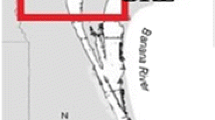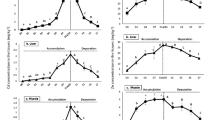Abstract
The accumulation of cadmium, its affinity for metallothioneins (MTs), and its relation to copper, zinc, and selenium were investigated in the experimental mudpuppy Necturus maculosus and the common toad Bufo bufo captured in nature. Specimens of N. maculosus were exposed to waterborne Cd (85 μg/L) for up to 40 days. Exposure resulted in tissue-dependent accumulation of Cd in the order kidney, gills > intestine, liver, brain > pancreas, skin, spleen, and gonads. During the 40-day exposure, concentrations increased close to 1 μg/g in kidneys and gills (0.64–0.95 and 0.52–0.76; n = 4), whereas the levels stayed below 0.5 in liver (0.14–0.29; n = 4) and other organs. Cd exposure was accompanied by an increase of Zn and Cu in kidneys and Zn in skin, while a decrease of Cu was observed in muscles and skin. Cytosol metallothioneins (MTs) were detected as Cu,Zn–thioneins in liver and Zn,Cu–thioneins in gills and kidney, with the presence of Se in all cases. After exposure, Cd binding to MTs was clearly observed in cytosol of gills as Zn,Cu,Cd–thionein and in pellet extract of kidneys as Zn,Cu,Cd–thioneins. The results indicate low Cd storage in liver with almost undetectable Cd in liver MT fractions. In field trapped Bufo bufo (spring and autumn animals), Cd levels were followed in four organs and found to be in the order kidney > liver (0.56–5.0 μg/g >0.03–0.72 μg/g; n = 11, spring and autumn animals), with no detectable Cd in muscle and skin. At the tissue level, high positive correlations between Cd, Cu, and Se were found in liver (all r > 0.80; α = 0.05, n = 5), and between Cd and Se in kidney (r = 0.76; n = 5) of autumn animals, possibly connected with the storage of excess elements in biologically inert forms. In the liver of spring animals, having higher tissue level of Cd than autumn ones, part of the Cd was identified as Cu,Zn,Cd–thioneins with traces of Se. As both species are special in having liver Cu levels higher than Zn, the observed highly preferential Cd load in kidney seems reasonable. The relatively low Cd found in liver can be attributed to its excretion through bile and its inability to displace Cu from MTs. The associations of selenium observed with Cd and/or Cu (on the tissue and cell level) point to selenium involvement in the detoxification of excessive cadmium and copper through immobilization.






Similar content being viewed by others
References
Martelli A, Rousselet E, Dycke C et al (2006) Cadmium toxicity in animal cells by interference with essential metals. Biochimie 88:1807–1814
Kägi JHR (1993) Evolution, structure and chemical activity of class I metallothioneins: an overview. In: Imura N, Kimura M, Suzuki KT (eds) Metallothionein III. Birkhauser, Basel, pp 29–56
Coyle P, Philcox JC, Carey LC, Rofe AM (2002) Metallothionein: the multipurpose protein. Review Cell Mol Life Sci 59:627–647
Bremner I (1993) Metallothionein in copper deficiency and toxicity. In: Anke M, Meissner D, Mills CF (Eds) Trace elements in man and animals, vol 8. NRC Research Press, Ottawa pp. 507-515
Maret W (2008). Thiol reactivity as a central aspect of metallothionein's mechanism of action. In: Zatta P (Ed) Metallothioneins in biochemistry and pathology. World Scientific, New Jersey, pp. 28-45.
Dobrovoljc K, Falnoga I, Bulog B, Tušek Žnidarič M, Ščančar J (2003) Hepatic metallothionein in two neoteric salamanders, Proteus anguinus and Necturus maculosus (Amphibia, Caudata). Comp Biochem Physiol 135C:285–294
Suzuki KT, Kawamura R (1984) Metallothionein present or induced in the three species of frogs Bombina orientalis, Bufo bufo japonicas and Hyla arborea japonica. Comp Biochem Physiol 79C:255–260
Goldfisher S, Schiller B, Sternlieb I (1970) Copper in hepatic lysosomes of the toad, Bufo marinus L. Nat 228:172–73
Pasanen S, Koskela P (1974) Seasonal changes in calcium, magnesium, copper and zinc content in the liver of the common frog Rana temporaria L. Comp Biochem Physiol 48:27–36
Suzuki KT, Itoh N, Ohta K, Sunaga H (1986) Amphibian metallothionein. Induction in the frogs Rana japonica, R. nigromaculata and Rhacophorus schlegelii. Comp Biochem Physiol 83C:253–259
Linde AR, Klein D, Summer KH (2005) Phenomenon of hepatic overload of Cu in Mugil cephalus: role of metallothioneins and patterns of copper distribution. Basic Clin Pharmacol Toxicol 97:230–235
Köherle J, Brigelius-Flohe R, Bock A, Gartner R, Meyer O, Flohe L (2000) Review: Selenium in biology: facts and medical perspectives. Biol Chem 381:849–864
Brown DD, Cai L (2007) Amphibian metamorphosis. Dev Biol 306:20–33
Lobanov AV, Hatfield DL, Gladyshev VN (2008) Reduced reliance of the trace element selenium during evolution of mammals. Genome Biol 9:R62
Sasakura S, Suzuki KT (1998) Biological interaction between transition metals (Ag, Cd and Hg), selenide/sulfide and selenoprotein P. J Inorganic Biochem 71:159–162
Burk RF, Hill KE (2005) Selenoprotein P: an extracellular protein with unique physical characteristics and a role in selenium homeostasis. Annu Rev Nutr 25:215–235
Hill CH (1975) Interrelationships of selenium with other trace elements. Fed Proc 34:2096–100
Curvin-Aralar MLA, Furness RW (1991) Mercury and selenium: a review. Ecotoxicol Environ Saf 21:348–364
Berry JP, Zhang L, Galle P (1995) Interaction of selenium with copper, silver, and gold salts. Electron microprobe study. J Submicrosc Cytol Pathol 27:21–28
Diplock AT, Watkins WJ, Hewison M (1986) Selenium and heavy metals. Annals Clin Res 18:55–66
Toman R, Golian J, Šiška B, Massanyi P, Lukáč N, Adamkovičevá M (2009) Cadmium and selenium in animal tissues and their interactions after an experimental administration to rats. Slovak J Anim Sci 42:115–118
Byrne AR, Kosta L, Stegnar P (1975) The occurrence of mercury in Amphibia. Environ Lett 8:147–155
Gailer J (2007) Arsenic–selenium and mercury–selenium bonds in biology. Coord Chem Rev 251:234–254
Viljoen AJ, Tappel AL (1988) Interactions of selenium and cadmium with metallothionein-like and other cytosolic proteins of rat kidney and liver. J Inorg Biochem 34:277–290
Takatera K, Osaki N, Yamaguchi H, Watanabe T (1994) HPLC/ICP mass spectrometric study of the selenium incorporation into cyanobacterial metallothionein induced under heavy-metal stress. Anal Sci 10:567–572
Falnoga I, Tušek Žnidarič M, Mazej D, Stibilj V, Dobrovoljc K (2005) Selenium and metallothionein association. Abstracts, The Fifth International Conference on Metallothioneins, Beijing, China, Oct. 8–12, p 21
Bulog B, Mihajl K, Jeran Z, Toman MJ (2002) Trace element concentrations in the tissues of Proteus anguinus (Amphibia, Caudata) and the surrounding environment. Water Air Soil Pollut 136:147–163
Stibilj V, Mazej D, Falnoga I (2003) A study of low level selenium determination by hydride generation atomic fluorescence spectrometry in water soluble protein and peptide fractions. Anal Bioanal Chem 337:1175–1183
Mazej D, Falnoga I, Veber M, Stibilj V (2006) Determination of selenium species in plant leaves by HPLC–UV–HG–AFS. Talanta 68:558–568
Klein D, Lichtmanegger J, Heizmann U, Müler-Höcker J, Summer KH (1999) Fate of copper and metallothionein in the liver of LEC rats. In: Klassen C (ed) Metallothionein IV. Birkhäuser, Basel, pp 403–412
Wong CK, Wong MH (2000) Morphological and biochemical changes in the gills of Tilapia (Oreochromis mossambicus) to ambient cadmium exposure. Aquat Toxicol 48:517–525
Smith PN, Cobb GP, Godard-Codding C, Hoff D, McMurray SC, Rainwater TR, Reynolds KD (2007) Contaminant exposure in terrestrial vertebrates. Environ Poll 150:41–64
Vogiatzis AK, Loumbourdis NS (1997) Uptake, tissue distribution and depuration of cadmium (Cd) in the frog Rana ridibunda. Bull Environ Contam Toxicol 59:770–776
Vogiatzis AK, Loumbourdis NS (1998) Cadmium accumulation in liver and kidneys and hepatic metallothionein and glutathione levels in Rana ridibunda, after exposure to CdCl2. Arch Environ Contam Toxicol 34:64–68
Mihajl K (1998). Tracing the microelements in the tissues and environments of Proteus anguinus (Urodela, Amphibia). Graduation thesis, University of Ljubljana (in Slovene)
Tjälve H, Henriksson J (1999) Uptake of metals in the brain via olfactory pathways. Neurotoxicol 20:181–196
Gu C, Chen S, Xu X, Zheng L, Li Y, Wu K, Liu J, Qi Z, Han D, Chen G, Huo X (2009) Lead and cadmium synergistically enhance the expression of divalent metal transporter 1 protein in central system of developing rats. Neurochem Res 34:1150–1156
James SM, Little EE, Semlitch RD (2004) The effect of soil composition and hydration on the bioavailability and toxicity of cadmium to hibernating juvenile American toads (Bufo americanus). Environ Pollut 132:523–532
Stawarz R, Fromicki G, (2003) Copper, zinc, cadmium and lead levels in fat bodies of adult female Rana esculenta L. During hibernation. Rizikové faktory potravového ret'azca III. Nitra, 133–38
Mihajl K (2002) Copper, zinc, and cadmium binding metallothionein in the liver of Proteus anguinus (Amphibia: Caudata). Master of Science thesis, University of Ljubljana (in Slovene)
Papadimitriou E, Loumbourdis LS (2003) Copper kinetics and hepatic metallothionein levels in the frog Rana ridibunda, after exposure to CuCl2. BioMetals 16:271–277
Sichel G, Scalia M, Corsaro C (2002) Amphibia Kupffer cells. Microscopy Res Tech 57:477–490
Barni S, Vaccarone R, Bertone V, Fraschini A, Bernini F, Fenoglio C (2002) Mechanisms of changes to the liver pigmentary component during the annual cycle (activity and hibernation) of Rana esculenta L. J Anat 200:185–194
Gallone A, Sagliano A, Guida G, Ito S, Wakamatsu K, Capozzi V, Perna G, Zanna P, Cicero R (2007) The melanogenic system of the liver pigmented macrophages of Rana esculenta L.—tyrosinase activity. Histol Histopathol 22:1065–75
Hong L, Simon JD (2007) Current understanding of the binding sites, capacity, affinity, and biological significance of metals in melanin. J Phys Chem B 111:7938–7947
Balamurogan K, Hua H, Georgiev O, Schaffner W (2009) Mercury and cadmium trigger expression of the copper importer Ctr1B, which enables Drosophila to thrive on heavy metal-loaded food. Biol Chem 320:109–13
Gaetke LM, Chow CK (2003) Copper toxicity, oxidative stress, and antioxidant nutrients. Toxicol 189:147–63
Viarengo A (1989) Heavy metals in marine invertebrates: mechanisms of regulation and toxicity at the cellular level. CRC Crit Rev Aquat Sci 1:295–317
Berry JP, Galle P (1994) Selenium–arsenic interaction in renal cells: role of lysosomes. Electron microprobe study. J Submicrosc Cytol Pathol 26:203–106
Falnoga I, Tušek Žnidarič M (2007) Selenium–mercury interactions in man and animals. Biol Trace Elem Res 3:212–220
Loumburdis NS, Vogiatzis AK (2002) Impact of liver pigmentary system of the frog Rana ridibunda. Ecotoxicol Environmen 53:52–58
Ghost P, Thomas P (1995) Binding of metals to red drum vitellogenin and incorporation into oocytes. Mar Environ Res 39:165–168
Sunderman FW Jr, Katarzyna A, Antonijczuk A (1995) Xenopus lipovitellin1 is an Zn2+- and Cd2+-binding protein. Mol Reprod Dev 42:180–187
Olsson PE, Zafarullah M, Gedamu L (1989) A role of metallothionein in zinc regulation after estradiol induction of vitogellin synthesis in rainbow trout, Salmo gardneri. Biochem J 257:555–559
Fabisiak JP, Tyurin VA, Tyurina YY, Borisenko GG, Korotaeva A, Pitt BR, Lazo JS, Kagan VE (1999) Redox regulation of copper–metallothionein. Arch Biochem Biophys 363:171–181
Acknowledgments
The authors are grateful to Dr. Anthony R. Byrne for critical reading of the manuscript. This study was supported by a grant from the Ministry of Higher Education, Science and Technology, Republic of Slovenia (through research program P1-0143 and through the PhD project of one of the authors—K. Dobrovoljc). The study was approved by the Veterinary Administration of the Republic of Slovenia and the Ministry of the Environment and Spatial Planning, and complies with the National and European Union guidelines for the care and treatment of laboratory animals.
Author information
Authors and Affiliations
Corresponding author
Rights and permissions
About this article
Cite this article
Dobrovoljc, K., Falnoga, I., Žnidarič, M.T. et al. Cd, Cu, Zn, Se, and Metallothioneins in Two Amphibians, Necturus maculosus (Amphibia, Caudata) and Bufo bufo (Amphibia, Anura). Biol Trace Elem Res 150, 178–194 (2012). https://doi.org/10.1007/s12011-012-9461-2
Received:
Accepted:
Published:
Issue Date:
DOI: https://doi.org/10.1007/s12011-012-9461-2




